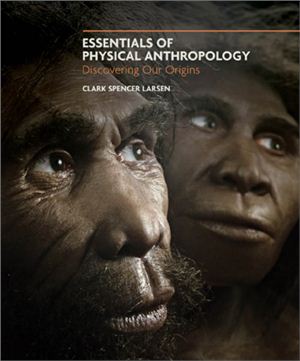W. W. Norton & Company, 2010, 433 pages
The #1 text in physical anthropology, now in a brief edition.
With the same unparalleled art and inquiry-based pedagogy as the best-selling Our Origins, Essentials of Physical Anthropology is the ideal text for focusing students’ attention on what really matters and why. Author Clark Larsen, one of the world’s leading physical anthropologists, has worked hard to develop a tight narrative, covering only the most pertinent, most up-to-date information that students should know. Pedagogical features in every chapter keep students focused on the core concepts and big questions in physical anthropology. An extensive art program, including figures, photos, maps, and bubble captions, brings concepts to life.
The book is divided into two parts. Following an introductory overview of anthropology and physical anthropology, Part I presents the key principles and concepts in biology, especially from an evolutionary perspective. This material draws largely on the study of living organisms, including humans and nonhuman primates. Because much of our understanding of the past is drawn from what we have leaed from the present, this part lays the foundation for the presentation in Part II—the past record of primate and human evolution. In putting the record of the living up front, this book departs from the style of most other introductory physical anthropology textbooks, which start out with the earliest record and end with the living. This book takes the position that most of what we lea about the past is based on theory and principles leaed from the living record. Just as all of Charles Darwin’s ideas were fi rst derived from seeing living plants and animals, much of our understanding of function and adaptation come from living organisms as models. Therefore, this book views the living as the window onto what came before. Individual chapters, however, can be taught in any order.
Part II presents evidence of the past, covering more than 50,000,000 years of evolution. Most textbooks of this kind end the record of human evolution at about 25,000 years ago, when mode Homo sapiens evolved worldwide. This textbook also provides the record since the appearance of mode humans, showing that important biological changes occurred in just the last 10,000 years, largely relating to the shift from hunting and gathering to the domestication of
plants and animals. Food production was a revolutionary development in the human story, and Part II presents this remarkable record, including changes in health and well-being that continue today. A new subdiscipline of physical anthropology, bioarchaeology, is contributing new and profound insights into the last 10,000 years, one of the most dynamic periods of human evolution.
The #1 text in physical anthropology, now in a brief edition.
With the same unparalleled art and inquiry-based pedagogy as the best-selling Our Origins, Essentials of Physical Anthropology is the ideal text for focusing students’ attention on what really matters and why. Author Clark Larsen, one of the world’s leading physical anthropologists, has worked hard to develop a tight narrative, covering only the most pertinent, most up-to-date information that students should know. Pedagogical features in every chapter keep students focused on the core concepts and big questions in physical anthropology. An extensive art program, including figures, photos, maps, and bubble captions, brings concepts to life.
The book is divided into two parts. Following an introductory overview of anthropology and physical anthropology, Part I presents the key principles and concepts in biology, especially from an evolutionary perspective. This material draws largely on the study of living organisms, including humans and nonhuman primates. Because much of our understanding of the past is drawn from what we have leaed from the present, this part lays the foundation for the presentation in Part II—the past record of primate and human evolution. In putting the record of the living up front, this book departs from the style of most other introductory physical anthropology textbooks, which start out with the earliest record and end with the living. This book takes the position that most of what we lea about the past is based on theory and principles leaed from the living record. Just as all of Charles Darwin’s ideas were fi rst derived from seeing living plants and animals, much of our understanding of function and adaptation come from living organisms as models. Therefore, this book views the living as the window onto what came before. Individual chapters, however, can be taught in any order.
Part II presents evidence of the past, covering more than 50,000,000 years of evolution. Most textbooks of this kind end the record of human evolution at about 25,000 years ago, when mode Homo sapiens evolved worldwide. This textbook also provides the record since the appearance of mode humans, showing that important biological changes occurred in just the last 10,000 years, largely relating to the shift from hunting and gathering to the domestication of
plants and animals. Food production was a revolutionary development in the human story, and Part II presents this remarkable record, including changes in health and well-being that continue today. A new subdiscipline of physical anthropology, bioarchaeology, is contributing new and profound insights into the last 10,000 years, one of the most dynamic periods of human evolution.

